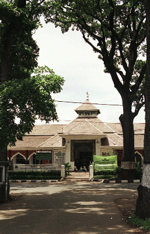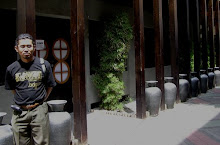mohon maaf sudah lama sekali rasanya tidak mengupdate blog saya ini.
Menanggapi beberapa permintaan dari pembaca, insyaAllah akan saya hidupkan lagi nih ;-). ok. untuk mengawali, saya posting jawaban beberapa pertanyaan baru-baru ini. Semoga bermanfaat.
Bila ada pendapat yang lain, silahkan dikomentari atau diskusikan lebih lanjut.
-------------
Trish Anderton
wrote:
Dear Pak Bambang: I am writing a story on
Indonesian mosque architecture for the Indonesian Heritage Society. I have read some of your works on Javanese mosques online and would love to ask you some questions, either by phone or online. Is this possible?
Thanks!
Trish Anderton
Jakarta
--------------
On Mon, Apr 14, 2008 at 8:05 PM, Trish Anderton
So what i would like to know is:
Are there particular symbols or architectural features that every mosque has? For example, every Catholic church has a cross. Is there an equivalent in Islam?
How different are Indonesian mosques from Arab mosques?
Are mosques usually rectangular? Why is the classic Javanese mosque square?
What kinds of mosques are people building here now? Are they different from Javanese mosques? What are the major influences on mosque architecture in Indonesia right now?
Do most mosques being built in Indonesia today
have a separate area for women, or not?
Thanks!
Trish
--------------
Dear Mr. Trish Anderton,
I am so sorry for being very-very late to answer your
questions because my bustle and I have a problem with
my computer by local virus ;-( until today.
Below, I try to answer your questions.
Regards,
Bambang
--------------------------------------
1. Are there particular symbols or architectural
features that every mosque has? For example, every
Catholic church has a cross. Is there an equivalent in
Islam?
Answer:
There is no symbol or architectural feature that every
mosque must have. Even though many mosques have some elements or architectural features that widely associated with mosque by many people elsewhere but actually there is no rule/no law in Sharia (Koran and
Hadits) and also no “consensus” of Islamic believer
that every mosque must have it. Some elements or
architectural features are qibla wall, mihrab (niche),
minbar (pulpit), minaret, kubah or dome, arches, moon
and star, etc.
2. How different are Indonesian mosques from Arab
mosques?
Answer:
Of course there are so many differences in
architectural expression between Indonesian mosque and
Arab mosque. For example the plan: Indonesian mosque
is generally square and Arab mosque is generally
rectangular or hypostyle. The material: Indonesian
mosque generally wood or timber and Arab mosque is
brick or marble. The roof: Indonesian mosque generally
tiered roof and Arab mosque is flat or/with small
dome. However, this is only general or main
characteristics. Mosque architecture has many types
and developments in their region. Architectural
expression of mosque is very rich especially in
contemporary design.
3. Are mosques usually rectangular? Why is the classic
Javanese mosque square?
Answer:
No, They aren’t. The geometry of mosque plan is usually
not only rectangular but also square. In architectural
tradition/precedent, mosque has generally square and
rectangular and not to be circle or oval or other
geometry in plan. We can understand it because the
plan must fit with the function: shaff (line) of
prayer facing to qibla/mecca. Regarding the classic
Javanese mosque is generally square in plan, I argue
that it is very close relation with its form and
structure/construction. The classic Javanese mosques
generally open halls with “centred” tradition of tall,
multi-roofted with timber columns as structural
supports. I explained it in detail in my paper
entitled A Study on History and Development of the
Javanese Mosque - part 3 Typology of Plan and
Structure of the Javanese Mosque and Its Distribution,
Journal of Asian Architecture and Building
Engineering, 2006.
4. What kinds of mosques are people building here now?
Are they different from Javanese mosques? What are the
major influences on mosque architecture in Indonesia
right now?
Answer:
I can divide into two. First, mosque without architect
which means the mosque was built by community and
craftsmen. Thousand mosques were built by them. Many
of them were built with arches and domes for
architectural expression, even “instant dome” offered
for sale at the roadside. Second, mosque was designed
by architect. There are some types to approach:
traditionalism, “populism”, and modernism. Of course
for “populism” (with domes and arches) and modernism
(modern movement), they are quite different from the
Javanese mosque. I think “populism” is the major of
Indonesian mosque today. Indonesian people generally
recognizes that the building with dome and arches is
mosque.
5. Do most mosques being built in Indonesia today have
a separate area for women, or not?
Answer:
Yes, they do. Contemporary mosques in Indonesia also
have a separate area for women. Some of mosques have
“mezzanines” for women.
Thanks!
Trish
You are welcome.
Bambang



